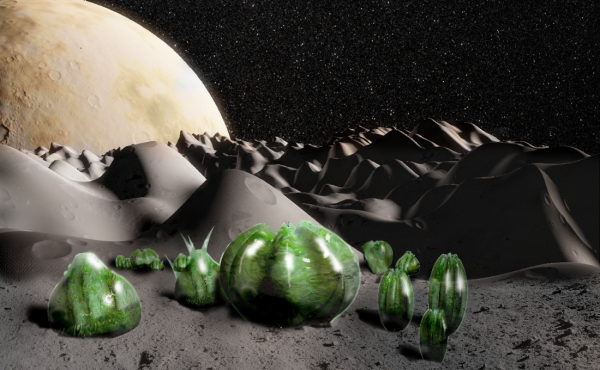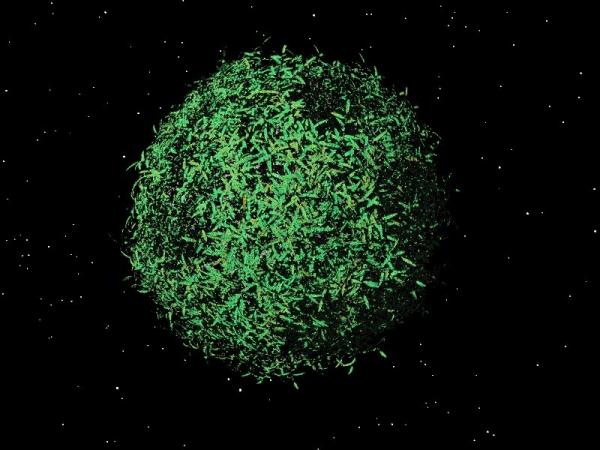BY LETTER
Vacuum Flora
 Image from Steve Bowers | |
| Terrarium plants on an airless moon | |
Vacuum Adapted Plants
Terrarium plants and vacuum cacti are two species of early, vacuum-adapted terragen astragens. Vacuum cacti were among the first broadly successful vacuum-adapted multi-cellular organisms, predating vacuum-adapted humans by decades with their first lunar and orbital station test trials taking place in 127 AT. They were developed specifically as proofs-of-concept for vacuum-adapted plants, and their success helped drive the creation of plants used in second to third century AT Martian terraforming, as well as many later projects like the Middle Solsys Era efforts to develop Dyson Trees. Terrarium plants were developed centuries later more as artwork than practical plants, but have uses beyond pure aesthetics.Vacuum Cacti
Terrestrial cacti were selected for their durability and suitable photosynthetic process, as well as the somewhat fanciful idea that such desert-dwelling plants would be "obviously" ideal for the lunar regolith and Martian soils. In fact, the required adaptations and genetic engineering tasks were numerous regardless of whether cacti or other plants were used. The first vacuum cacti (of lines that are still extant and popular) had such narrow temperature tolerances that they were only suited for space station hulls and near-Earth asteroids with day lengths under 50 hours. The problems for vacuum adaptation were numerous: carbon dioxide and nitrogen had to be acquired from new sources; regoliths and non-terrestrial soils were typically moisture- and nutrient-deficient; near-surface soil temperatures could swing from +125 to -125C even in suitable illumination levels; and so on.Early cacti avoided solving all those problems. Instead, they were gardened in nutrient-rich, watered soils on artificial satellites, or outside asteroid bases supporting their research and development. Here, temperature could also be regulated by assorted means such as shading, soil heaters, or predictable diurnal temperature swings. Moisture was typically provided in vacuum-stable forms like hydrated materials (e.g., clays) or as frost below an insulating regolith crust.
Such vacuum cacti were not robust and fast growing like later atragens, but they demonstrated that plants could survive in vacuum. The key success was in adopting crassulacean acid metabolism (CAM) and C4 photosynthesis processes to the rigors of vacuum: the early vacuum cacti first reduced carbon dioxide, oxygen, and water loss rates, and later halted them almost entirely. They instead carefully held and recycled those materials, typically shuttling them between intracellular spaces and active areas using techniques that varied by engineering design group and era. Modern, entirely biological vacuum cacti typically store not only large quantities of water in their stems, but also carbon- and nitrogen-rich chemicals (such as sugars and nitrogenous bases) that the plants can draw on in times of scarcity.
Other vacuum adaptations were developed prior to the Technocalypse. Vacuum cacti were adapted to extended solar heating by four major techniques, not all of which were present in a given vacuum cactus species: photoresponsive skins that altered albedo; water-costly transpiration cooling; high thermal mass, to slow temperature change of the plant; and geothermal heat exchange, using sap circulation through roots in cool regolith to keep the plant cool. Low temperatures were addressed by thermal mass; metabolic heat generation, typically using sugars and oxygen accumulated in daytime; and geothermal heat exchange. Designers also worked throughout the pre-Technocalypse era to improve the tolerance of the plants biology to heat and cold. Freeze-tolerant cacti were an early success in adapting the plants to the chill of extended darkness, like the lunar night — the plants could simply freeze without harm and then thaw during the day.
In addition, vacuum cacti often had roots and metabolisms tolerant of aggressive chemicals, like those found in asteroid regolith.
Finally, pollination and seed dispersal were often addressed by gaseous or mechanical means. The mechanical dispersion of seeds and pollen was readily adapted from terrestrial plants like the Himalayan Balsam, while translating the gaseous dispersion of the Puffball Fungus followed a few decades later.
By the time of the Technocalypse, vacuum cacti had been relegated to garden plants because terraforming programs had developed highly productive and adaptable species of terraforming and food plants.
Terrarium Plants
Terrarium plants are a distinct offshoot of vacuum cacti created for aesthetic and academic purposes. The original concept of terrarium plants was to create a plant with a closed internal ecosystem using additional, symbiotic species that would live within the plant. Such an idea, implemented in a very different fashion and scale, is also found in Dyson Trees and Green Bubbles. In fact, surviving records indicate that Interstellar Era genetic engineers working on Dyson Tree projects intended to use such complete internal ecosystems, though modern Dyson Trees have a much more limited range of symbiotes.Vacuum cacti designers eventually found biological processes that eliminated the need for entire, separate species to be included in the astragens. The idea might've languished if not for efforts by a 252AT artist's plan to create "the first fully biological space station." Because the first terrarium plants were little larger than typical terrestrial cacti their claim to be "biological space stations" is disputed. On the other hand, various lineages of terrarium plants have produced popular garden plants and wild astragens.
Typical terrarium plants are enlarged, thin-skinned cacti with one or more transparent chambers containing mixes of gases and nutrient-rich water. In those chambers are various other species forming a relatively closed ecosystem: bacteria, algae, plants, fish, snails, and so forth. When gravity is not present to a substantial degree, there are usually mechanisms to actively separate liquid- and gas-zones, such as fine roots that hold water by surface tension or mats of algae. The stable air- and water zones enable a greater diversity of aquatic and air-breathing species than an unpredictably mixed internal environment.
Though initially conceived as a completely enclosed ecosystem, few strains of terrarium plants succeed in that goal. Instead, they depend on the host cactus extracting nutrients, minerals, and water from the regolith or soil to which it is anchored, which are then made available to species inside by various mechanisms. Terrarium plants tend to be more limited in the space environments in which they can survive than vacuum cacti, as enduring greater temperature ranges or environments necessarily means engineering all the species within the plants. However, there are strains of terrarium plants that can survive on the rigors of Luna, with the mobile internal species seeking shelter in warm internal or underground portions of the plant while above ground extremities freeze. Numerous genes derived from tardigrades are critical in helping terrarium plants' animals survive hibernation periods and radiation.
Terrarium plants may look vastly different than their ancestral cacti, losing unnecessary spines and bloating around "vivarium chambers." Plants intended for wild growth may also feature the ability to merge at contact points, allowing their environments to interconnect and form an enlarged, more diverse ecosystem. Taken to the extreme, some lines of terrarium plants are large enough to be habitats and approach Green Bubble scales. At the other end of their size scale, terrarium plants are raised for aesthetic purposes similar to bonsai trees: plants (and vivariums) in miniature.
These plants are not efficient food sources, but they can offer an unusual diversity of nutrition in a single hybrid organism. The "Bottle Kitchen" line of terrarium plants grow a variety of nutritional plants and flavorable herbs within inedible cacti frame, tended and supported by edible insects, snails, and fish.
Other environments
The original vacuum cacti and terrarium plants were intended for mild vacuum environments, but the success of the hardy plants meant they have been re-adapted back to non-terrestrial planetary environments. Variants of both astragens can be found on adamaean, lithicgelidian, amunian, and arean worlds, and terrarium plants may also be found on gaian worlds, often as houseplants or in ornamental gardens.Dyson Trees
While numerous terraforming plants and early Dyson Tree programs derived some benefit from research into vacuum cacti, few astragen are directly descended from the cacti. Dyson Trees, for example, needed radical growth enhancements to be able to grow by millions of tons per year and shared little with cacti other than a few vacuum-adaptation genes. Image from Anders Sandberg |
Related Articles
Appears in Topics
Development Notes
Text by Mike Miller
Initially published on 04 April 2018.
Initially published on 04 April 2018.






